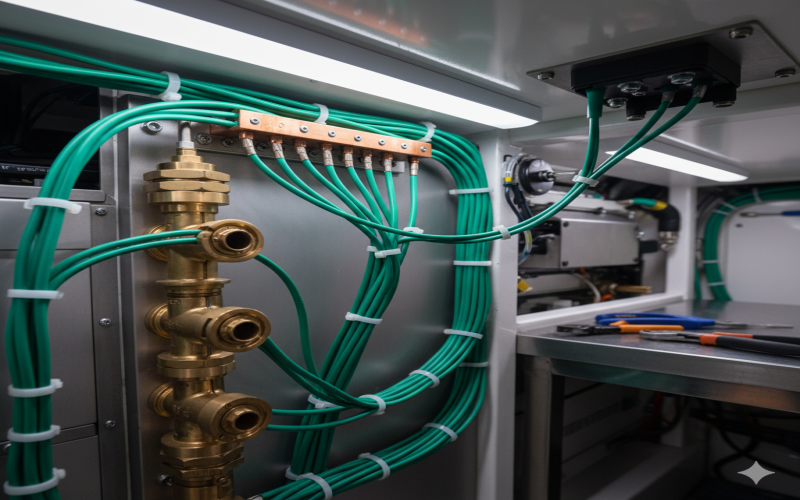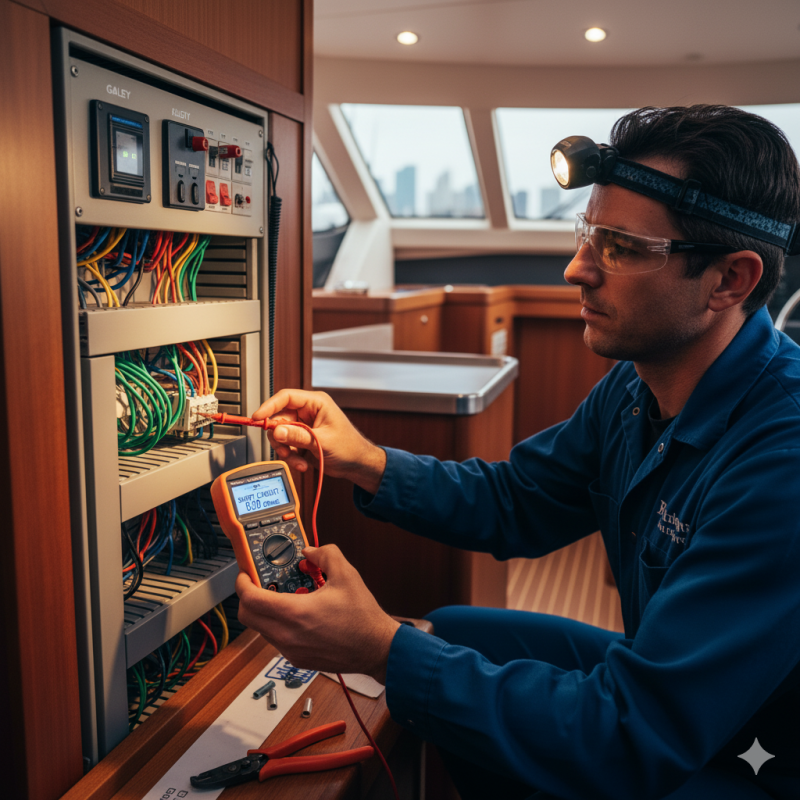
What is a Marine Bonding System and Why is it Essential?
In a saltwater boat maintenance environment, your vessel is under constant attack. The mix of different metals, conductive saltwater, and stray electrical currents creates a perfect storm for galvanic corrosion. This is more than just a cosmetic issue; this silent destroyer can ruin propellers, shafts, and through-hulls, leading to expensive repairs. An effective boat bonding system, also known as marine grounding, is the single most important defense for underwater metal protection and preventing this costly damage. This guide will explain what a marine bonding system is and how it works to protect your investment.
Key Components of Your Boat's Electrical Grounding System
- Marine Sacrificial Anodes (Zincs) – The heart of yacht corrosion prevention. These are blocks of a more reactive metal (zinc for saltwater) attached to the bonding circuit. They are designed to corrode first, sacrificing themselves to protect your expensive bronze propellers and stainless steel shafts. Replacing boat zincs on a regular schedule is a critical part of yacht maintenance.
- Bonding Wires – This is the nervous system of your corrosion protection. Green, insulated marine-grade copper wire (typically 8 AWG marine grounding wire size) connects all major underwater metal components into a single circuit, directing harmful electrical currents safely to your sacrificial anodes.
- Through-Hulls & Seacocks – As critical points of entry for water, these fittings are highly vulnerable. Protecting through-hulls from corrosion by connecting them to the bonding system is a non-negotiable safety requirement.
- Propellers, Struts & Shafts – Your drivetrain is one of the most expensive systems on your boat. The motion and mix of metals make it a primary target. Dedicated shaft anodes and a solid connection to the main bonding system are essential to prevent costly boat corrosion.
- Galvanic Isolator – Essential for any boat using shore power. This device blocks low-voltage DC currents that cause stray current corrosion, a rapid and aggressive form of boat corrosion often found in marinas. An isolator protects your boat from electrical issues originating from the dock or neighboring vessels.
Best Practices for How to Prevent Galvanic Corrosion on a Boat
- Regularly Inspect and Replace Sacrificial Anodes – Knowing how to install sacrificial anodes on a yacht is key, but knowing when to replace them is paramount. Inspect them at every haul-out and replace them when they are 50% gone. This is the most cost-effective way to prevent issues like wondering why your boat's propeller is corroding.
- Ensure Meticulous Bonding Connections – Every connection in the boat bonding system must be perfect. This means clean metal-to-metal contact, free of corrosion or paint. A poor connection is the same as no connection at all, leaving expensive components unprotected.
- Standardize Underwater Metals – Whenever possible, use the same high-quality, marine-grade metal for all underwater fittings. This reduces the galvanic potential between components and slows down the natural corrosion process.
- Perform Periodic Continuity and Hull Potential Tests – Don't just assume your system is working. Checking your boat's grounding system with a multimeter should be part of your routine. For a professional-level check, a reference electrode can measure the hull's potential to ensure it's in the optimal protected range.
Tools for Checking Your Boat's Grounding System
- Digital Multimeter – An essential diagnostic tool for every boat owner. Use it to perform continuity tests to hunt down and fix any breaks or poor connections in your bonding circuit.
- Silver/Silver-Chloride Reference Electrode – This is the professional's tool for accurately measuring a vessel's hull potential, providing a definitive reading on whether your anode system is providing adequate protection against galvanic corrosion.
- Corrosion Test Hammer – A simple but highly effective tool. Lightly tapping on through-hulls allows you to listen for differences in tone. A solid ring indicates healthy metal, while a dull thud can be a sign of dangerous internal corrosion.
- High-Quality Wire Crimpers & Heat Shrink Connectors – Proper marine electrical work requires the right tools. Ensure your bonding wire connections are durable and moisture-proof by using professional-grade equipment.
Proactive Tips for Protecting Through-Hulls and Drivetrain
- Be Wary of Shore Power and Marina Wiring – Stray current corrosion from a neighboring boat's electrical fault or faulty dock wiring can destroy your underwater metals in weeks. A galvanic isolator is your best defense, and rapid anode wear is a major red flag that demands immediate investigation.
- Isolate Dissimilar Metals – Where different metals must meet, use non-conductive materials like Tef-Gel or insulating gaskets to separate them and break the electrical circuit that leads to corrosion.
- Maintain Your Barrier Coat – A high-quality epoxy barrier coat beneath your anti-fouling paint is more than just blister prevention; it's an excellent electrical insulator that provides a crucial layer of defense for the entire hull.
Pro tip: Think of your grounding system as your boat's immune system. A single break in the chain or a depleted anode is like a vulnerability, allowing the disease of corrosion to take hold. Vigilant, proactive maintenance is the only cure.
Professional Marine Electrical Service and Corrosion Management
A boat bonding system is a complex network that provides critical underwater metal protection. It is not a "set it and forget it" component. By understanding these principles and performing diligent yacht maintenance, you can protect your investment and ensure its safety. If you're experiencing signs of corrosion and are located in Southern California, seeking a professional marine corrosion inspection in Long Beach or San Pedro is a wise next step. Proper marine electrical service can diagnose issues a simple visual check might miss, saving you thousands in the long run.









